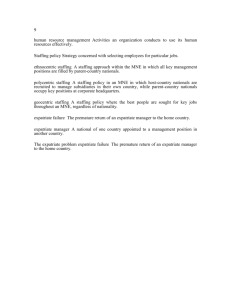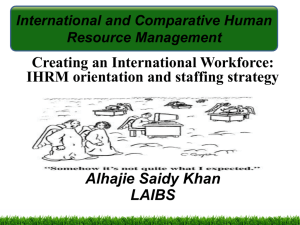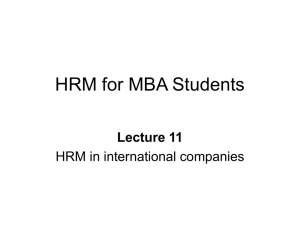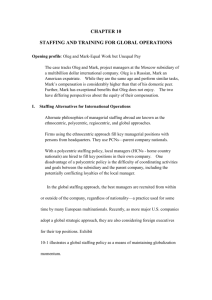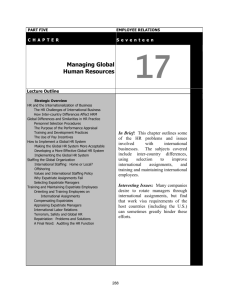Global Human Resource Management
advertisement
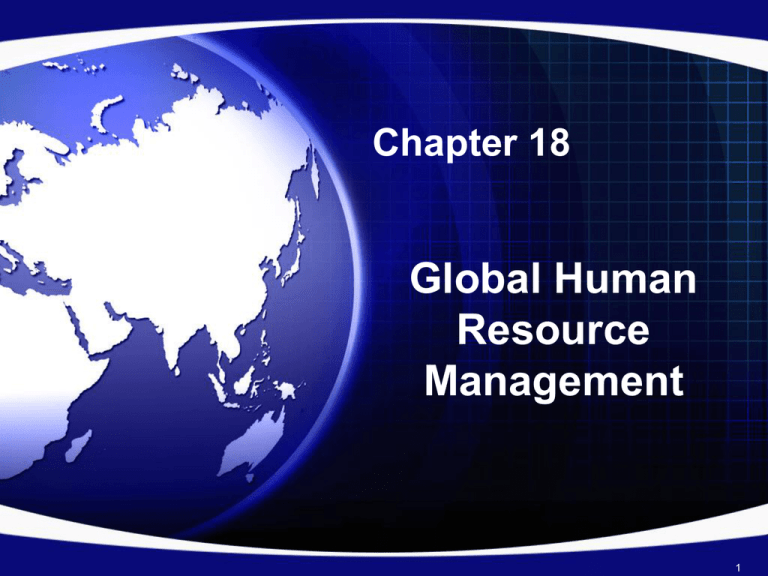
Chapter 18 Global Human Resource Management 1 Video Job Threat 2 Global Human Resource Management • Human resource management (HRM) refers to the activities an organization carries out to utilize its human resources effectively These activities include: • • • • • • Determining the firm's human resource strategy Staffing Performance evaluation Management development Compensation Labor relations 3 The Strategic Role Of International HRM The Role of Human Resources in Shaping Organizational Architecture 4 Staffing Policy • A firm’s staffing policy is concerned with the selection of employees who have the skills required to perform a particular job • A staffing policy can be a tool for developing an promoting the firm’s corporate culture • A strong corporate culture can help the firm implement its strategy 5 Types Of Staffing Policy There are three main approaches to staffing policy within international businesses: 1. The ethnocentric approach 2. The polycentric approach 3. The geocentric approach 6 Ethnocentric Staffing Policy The ethnocentric approach to staffing policy fills key management positions with parent-country nationals • It makes sense for firms with an international strategy Firms that pursue an ethnocentric policy believe that: • • • There is a lack of qualified individuals in the host country to fill senior management positions It is the best way to maintain a unified corporate culture Value can be created by transferring core competencies to a foreign operation via parent country nationals 7 Ethnocentric Staffing Policy The ethnocentric staffing policy is no longer popular with most firms because: • It limits advancement opportunities for host country nationals • It can lead to "cultural myopia" 8 Polycentric Staffing Policy The polycentric staffing policy recruits host country nationals to manage subsidiaries in their own country, and parent country nationals for positions at headquarters • It makes sense for firms pursuing a localization strategy The polycentric approach: • • Can minimize cultural myopia May be less expensive to implement than an ethnocentric policy 9 Polycentric Staffing Policy There are two disadvantages to the polycentric approach: • Host country nationals have limited opportunities to gain experience outside their own country • A gap can form between host country managers and parent country managers 10 Geocentric Staffing Policy The geocentric staffing policy seeks the best people, regardless of nationality for key jobs • • • This approach is consistent with building a strong unifying culture and informal management network It makes sense for firms pursuing either a global or transnational strategy Immigration policies of national governments may limit the ability of a firm to pursue this policy 11 Geocentric Staffing Policy The geocentric approach: • • • • Enables the firm to make the best use of its human resources Builds a cadre of international executives who feel at home working in a number of different cultures Can be limited by immigration laws Is costly to implement 12 Types Of Staffing Policy Comparison of Staffing Approaches 13 Expatriate Managers • Expatriate failure is the premature return of an expatriate manager to his or her home country – Between 16 and 40 percent of all American expatriates in developed countries fail to complete their assignments, and almost 70 percent of Americans assigned to developing countries return home early – Each expatriate failure can cost between $250,000 and $1 million 14 Expatriate Managers Research shows the main reasons for expatriate failure for U.S. multinationals are: • • • • • The inability of an expatriate's spouse to adapt the inability of the employee to adjust The manager’s inability to adjust Other family-related reasons The manager’s personal or emotional maturity The manager’s inability to cope with larger overseas responsibilities 15 Expatriate Managers For European firms, only one reason was found to consistently explain expatriate failure: • The inability of the manager’s spouse to adjust to a new environment For Japanese firms, the reasons for failure are: • • • • • The inability to cope with larger overseas responsibility Difficulties with the new environment Personal or emotional problems A lack of technical competence The inability of spouse to adjust 16 Expatriate Managers • Firms can reduce expatriate failure through improved selection procedures Four dimensions that predict expatriate success are: 1. Self-orientation - the expatriate's self-esteem, selfconfidence, and mental well-being 2. Others-orientation - the ability to interact effectively with host-country nationals 3. Perceptual ability - the ability to understand why people of other countries behave the way they do 4. Cultural toughness – the ability to adjust to the posting 17 The Global Mindset • A global mindset may be the fundamental attribute of a global manager – A global mindset is often acquired early in life from a family that is bicultural, lives in foreign countries, or learns foreign languages as a regular part of family life 18 Training And Management Development • Training focuses upon preparing the manager for a specific job – Management development is concerned with developing the skills of the manager over his or her career with the firm – Historically, most firms focus more on training than on management development 19 Training For Expatriate Managers • Cultural training, language training, and practical training all help reduce expatriate failure – Yet, according to one study only about 30 percent of managers sent on one- to five-year expatriate assignments received training before their departure 20 Repatriation Of Expatriates • Preparing and developing expatriate managers for reentry into their home country organization is an important part of training and development – HRM needs to develop good programs for re-integrating expatriates back into work life within their home country organization once their foreign assignment is over, and for utilizing the knowledge they acquired while abroad 21 Performance Appraisal • Performance appraisal systems are part of the firm’s control system • Evaluating expatriates can be especially complex 22 Performance Appraisal Problems • Typically, both host nation managers and home office managers evaluate the performance of expatriate managers • Both types of managers are subject to unintentional bias – Home country managers tend to rely on hard data when evaluating expatriates – Host country managers can be biased towards their own frame of reference 23 Guidelines For Performance Appraisal To reduce bias in performance appraisal: • • • Most expatriates believe more weight should be given to an on-site manager's appraisal than to an off-site manager's appraisal A former expatriate who has served in the same location could be involved in the appraisal process to help reduce bias When foreign on-site mangers write performance evaluations, home office managers should be consulted before an on-site manager completes a formal termination evaluation 24 Compensation Firms face two key issues on compensation: 1. How to adjust compensation to reflect differences in economic circumstances and compensation practices 2. How to pay expatriate managers 25 National Differences In Compensation • There are substantial differences in executive compensation across countries – • Firms have to decide whether to pay executives in different countries according to the prevailing standards in each country, or equalize pay on a global basis – • In the U.S., a top HR executive made an average of $525,923 in the 2005-2006 period, compared to $237,697 in Japan, and just $158,146 in Taiwan This is an especially challenging issue in firms with geocentric staffing policies Many firms have recently moved toward a compensation structure that is based on global standards 26 Expatriate Pay • Most firms use the balance sheet approach to pay – This equalizes purchasing power across countries so employees have the same living standard in their foreign posting as at home An expatriate’s compensation package is made up of: 1. Base salary + Bonus + Long Term Incentives 2. 3. 4. 5. Foreign service premium (if appropriate) Various allowances Tax differentials Benefits 27 Expatriate Pay 1. Base Salary • • An expatriate’s base salary is normally in the same range as the base salary for a similar position in the home country Base salary can be paid wither in the home currency or in the local currency 2. Foreign Service Premium • • A foreign service premium is extra pay the expatriate receives for working outside his or her country of origin It is generally offered as an incentive to accept foreign assignments 28 Expatriate Pay 3. Allowances Expatriate compensation package often include : • Housing allowances • Cost-of-living allowances • Education allowances 29 Expatriate Pay 4. Taxation • The expatriate may have to pay income tax to both the home country and the host-country governments if the host country does not have a reciprocal tax treaty with the expatriate’s home country 5. Benefits • Many firms provide the same level of medical and pension benefits abroad that they received at home 30 International Labor Relations • The key issue in international labor relations is the degree to which organized labor is able to limit the choices available to an international business – A firm's ability to pursue a transnational or global strategy can be significantly constrained by the actions of labor unions – HRM needs to foster harmony and minimize conflict between the firm and organized labor 31 The Concerns of Organized Labor • The bargaining power of unions comes from their ability to threaten to disrupt production by striking or protesting • However, organized labor is concerned that: – – – Multinationals can counter union bargaining power by threatening to move production to another country Multinationals will farm out only low-skilled jobs to foreign plants making it easier to switch production locations Multinationals will import employment practices and contractual agreements from their home countries and reduce the influence of unions 32 The Strategy Of Organized Labor Organized labor has responded to the increased bargaining power of multinational corporations by: • • • • Trying to set-up their own international organizations Lobbying for national legislation to restrict multinationals Trying to achieve regulations of multinationals through international organization such as the united nations These efforts have had limited success 33
